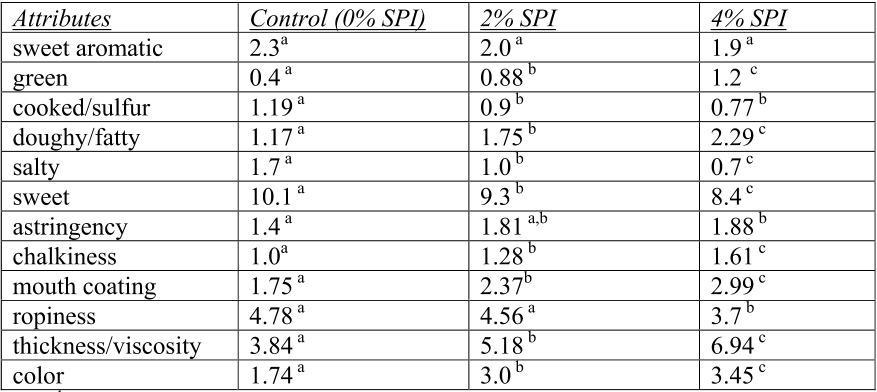
Abstract
FRIEDECK, KRISTOFER GREGG. Soy Protein Fortification of a Low Fat Dairy-
Based Ice Cream. (Under the direction of Dr. MaryAnne Drake.)
Since the inception of the 1998 FDA approved health claims linking soy and
health, soy protein has been investigated as a potential ingredient in many foods.
Products containing soy protein have been characterized as having beany or woody off-
flavors, which are unacceptable to many American consumers. Frozen dairy dessert
products, in comparison, are appealing to many consumers and may potentially serve as
carriers for functional ingredients such as soy protein. Understanding the flavor and
sensory impact of soy protein in a dairy-based frozen dessert is important in designing
soy fortified dairy products with high market acceptability. The goals of this research are
to identify and characterize aroma active compounds contributing to off flavors in soy
protein fortified dairy-based frozen desserts, and assess associated sensory impacts.
Descriptive sensory analysis was conducted on frozen dairy dessert mixes
formulated with 0, 2, and 4% soy protein isolate (SPI). Duplicate samples (750g)
containing an internal standard were distilled by high vacuum transfer followed by
extraction of the distillate with diethyl ether. Extracts containing volatile compounds
were separated into neutral-basic and acidic fractions and analyzed by gas
chromatography-mass spectroscopy (GC-MS) and gas chromatography-olfactometry
(GC-O) and aroma extract dilution analysis (AEDA). Comparison of retention indices,
odor properties, and GC-MS data against reference standards was performed for
identification of compounds. SPI fortified dessert mixes displayed different textural and
color properties in comparison to the 0 % SPI control. Soy fortification increased mouth

viscosity and mouthcoating. Green/grassy and doughy/fatty flavors increased in intensity
with added SPI. GC-O analysis revealed higher concentrations of hexanal (green), (Z)-4-
heptanal (fishy/oily), 2-acetyl-1-pyrroline (nutty/popcorn), and (E,E)-2,4-decadienal
(fatty/frier oil) in the SPI fortified samples compared to controls. Consumer testing
revealed lower acceptability of SPI fortified ice creams in conjunction with lower
intensities of pleasing ice cream flavors with added SPI. Chocolate flavored SPI fortified
ice creams received higher acceptability scores than vanilla flavored SPI fortified ice
creams. Consumers indicated a general knowledge of the healthfulness of low fat dairy
desserts and soy foods. This information will aid in the design and optimization of an
acceptable soy fortified low fat dairy ice cream.


ii
Biography
Kristofer Gregg Friedeck was born on January 4, 1975, in Seguin, Texas to
Walter and Jan Friedeck. His family also includes his wife Melanie, and sister, Michelle.
Kristofer graduated from Southwest Texas State University in August, 2000 with
a Bachelor of Science degree in Nutrition and Foods. Kristofer began work in Houston
Texas at H.E.B. Grocery Company in November 2000 where he worked as a Chef. He
left H.E.B. in April 2001 to pursue a Master of Science degree in Food Science at North
Carolina State University.

iii
Acknowledgments
The author would like to express his appreciation for the support and
encouragement provided by his wife, family, friends, laboratory colleagues, and major
advisor.
The author is thankful to Yonca Karagul for all of her expertise, technical
assistance, and patience. Also appreciation is given to Jamie Parker and Mary Whetstine
for all of their help, friendship, and mutual folly. Dr Mary Anne Drake deserves many
thanks for her role as a major advisor and mentor.
Particular thanks is given to the Food Science department faculty, staff, and
students at NCSU, who were so warm and welcoming, and always eager to lend a hand
whenever the need arose.
Most deserving of credit for the completion of this degree are the author’s family.
This endeavor was greatly facilitated by their continuous support and encouragement.
Immense gratitude is expressed toward Melanie for her immeasurable love, commitment,
and strength during completion of this degree.





